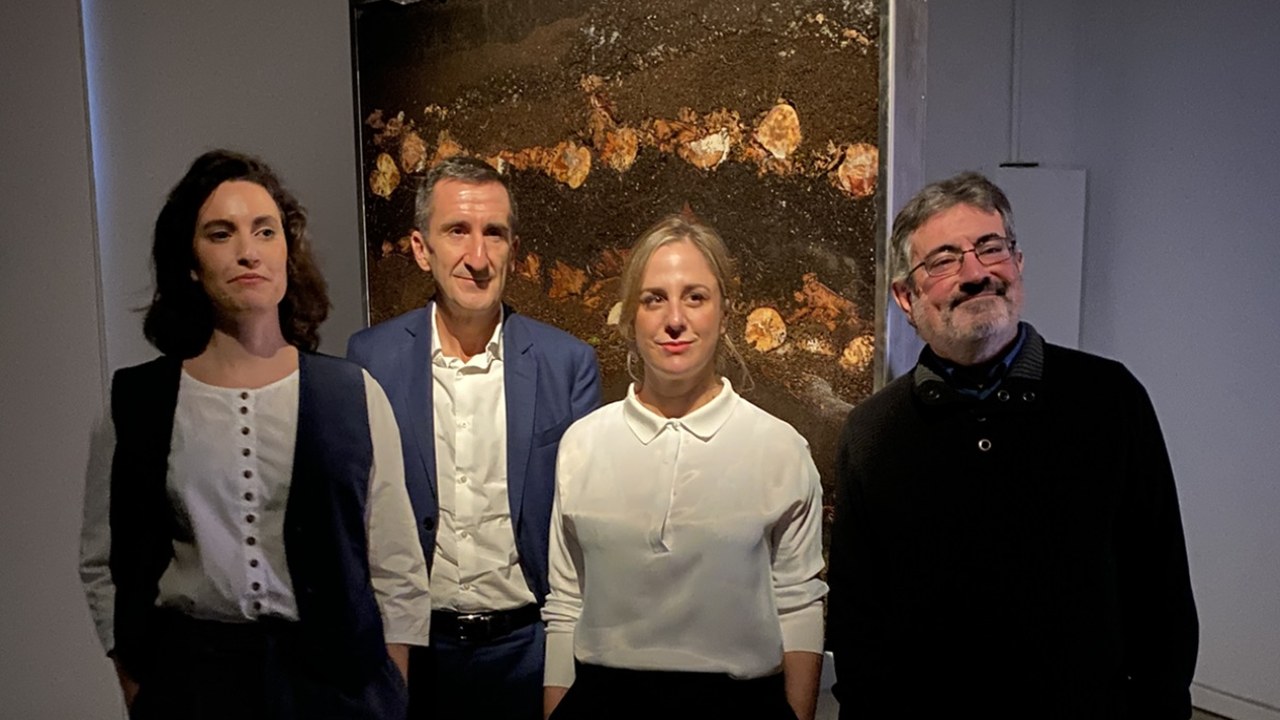DIPC participates in "Máquinas de Ingenio" exhibition at Tabakalera with the prototype entitled "Compost Computacional"
The exhibition "Máquinas de ingenio. Jakintzen bidegurutzean" presents a series of prototypes resulting from intense work processes that Tabakalera has driven around the Art, Science, Technology, and Society (ACTS) focus throughout 2023. The projects have been led by artists Marina Otero Verzier, Laura MM, Amaia Vicente, and Elsa Yranzo, developed in close collaboration between science and technology partners like the Donostia International Physics Center, Tekniker, BCC Innovation, and the Basque Center on Cognition, Brain, and Language, along with Tabakalera-associated citizen communities.

EXHIBITION
24 NOV 2023 - 04 FEB 2024 | Tuesday to Sunday: 12pm-14pm / 16pm-20pm | Exhibition Hall
The artistic prototype entitled "Compost Computational" developed in collaboration between DIPC researchers Txomin Romero, Silvia Bonoli, Raúl Angulo and Jens Stücker, Fernando Álvarez González (EHU) and architect and researcher Marina Otero Verzier is on display at the exhibition "Maquinas de ingenio. Jakintzen bidegurutzean" at Tabakalera.
The exhibition Máquinas de ingenio. Jakintzen bidegurutzean, curated by Maria Ptqk, presents four prototypes in the form of art installations that demonstrate a new way of working at the intersection between art, science, and technology to collectively address issues associated with the challenges of our time. The exhibition brings together vast diversity in the field of Art, Science, Technology, and Society (ACTS), such as studies on robotics, neuroscience, nutrition, data visualisation, and engineering that enter into dialogue with the languages of speculative design and art. Instead of being the simple sum of certain specialities, these processes are a stream of connected practices and a space for coming together and reflecting on contemporary techno-scientific culture, along with its potential and challenges.
FOUR ARTISTIC PROTOTYPES
The title of this exhibition, “Ingenious Machines”, is a reference to the name given to the inventions driven by the advancement of science since the Renaissance. These devices represent the cutting-edge technology of their time, and have a strong experimental nature: they are prototypes, test-phase trials that have provided specific responses to the needs of their social context. They are also the fruit of combined talents in collaboration, created in “workshop mode”, involving artists, craftsmen, scientists, designers, philosophers, poets, engineers, and mathematicians. With this idea, the prototypes shown in this exhibition arise from the meeting of four artists: Marina Otero Verzier, Laura MM, Amaia Vicente, and Elsa Yranzo, along with four scientific research projects, which were developed by collaborator technology and science centre research teams in 2023. A large platform installed in the exhibition hall with four audiovisual installations created by Morgan Crea that bring together the four prototypes' creative processes serves as an introduction to the exhibition.
- Exographies is the third collaboration between Tekniker and Tabakalera in the ACTS line of work: Developed by artist Amaia Vicente and Tekniker researchers Johan Kildal and Ane San Martin with collaboration from Gogoa Mobility Robots.
- C. El punto justo del conflicto cognitivo is a collaboration between artist Laura MM, researchers Manuela Ruzzoli and Marta La Pietra from the Basque Center on Cognition, Brain, and Language (BCBL), and the Neurohacking group from Medialab Tabakalera.
- Sugar Detox Clinic, this first collaboration between BCC Innovation, the technology centre specialised in gastronomy of the Basque Culinary Center, and Tabakalera is a creation by artist Elsa Yranzo, PhD in culinary sciences Elena Romeo, and researcher chef Nahuel Pazos.
- Compost computacional (Computational compost) is the result of the third collaboration between the Donostia International Physics Center (DIPC) and Tabakalera, the work of the architect and researcher Marina Otero Verzier with scientific collaboration from Txomin Romero, Silvia Bonoli, Raúl Angulo, Jens Stücker, and Fernando Álvarez González (UPV-EHU).
COMPOST COMPUTACIONAL (COMPUTATIONAL COMPOST) ARTISTIC PROTOTYPE
The work examines the environmental impact of data storage, highlighting the apparent volatility of digital information that, in the real world, requires massive amounts of physical infrastructure consuming energy, water, and raw materials. The piece asks a crucial question about the sustainability of these infrastructures in light of the future roll-out of technologies like artificial intelligence. The installation incorporates a vermicompost system fed by the heat of DIPC astronomic simulations, and presents an Incan quipu in the form of a film. Compost computacional highlights the political, ecological, and cultural dimension of design decisions, urging a critical re-evaluation of the digital future’s narratives.
TABAKALERA'S TRAJECTORY IN ACTS (2020-2022)
Housed in Tabakalera’s North Hall, the exhibition offers a comprehensive perspective on the convergence of art, science, technology, and society by presenting collaborations since 2020. Highlighting Clouds of Pollen from Grow Your Own Cloud (Monika Seyfried and Cyrus Clarke), with physicist Steen Rasmussen and the Donostia International Physics Center (DIPC), the work explores the storage of data in synthetic DNA molecules, addressing challenges similar to those presented in Compost Computational. Other prototypes include Dream Painter from Varvara & Mar, a robotic arm that transforms dream narrations into pictorial representations, and Holobot. Social Garden from VR Kommand, which creates holographic installations based on social media behaviours.
These prototypes are presented through audiovisual documentation, and Supraspectives by Quadrature, in collaboration with the DIPC and Ars Electronica Festival, are shown in documentary and installation format. The piece uses data from 590 satellites to calculate and speculatively reconstruct images of the Earth, exploring space junk and satellite observation. The exhibition illustrates Tabakalera’s commitment to projects that merge art and technology in an innovative way to provide a fascinating vision of the crossroads between creativity and scientific advances.
